By Scott Irwin and Todd Hubbs
Department of Agricultural and Consumer Economics
University of Illinois
It is generally acknowledged that the U.S. average corn yield is largely determined by weather conditions during the reproductive and grain filling stages during the summer months (e.g., Tannura, Irwin, and Good, 2008; Nielsen, 2015). Still, weather conditions during other times of the year, as well as the timeliness of planting, are known to influence the yield outcome. Wet conditions and a slow start to planting has heightened interest in whether it is still possible to plant the 2019 corn crop in a timely manner. In a farmdoc daily article last week (
April 17, 2019), we showed that weather is the key determinant of timely planting of the aggregate corn acreage in the U.S. and not planting rate per day, which is surprisingly stable through time. Given this finding, prospects for completing planting of the 2019 corn crop in a timely fashion depend on four specific factors: 1) the percentage of the crop already planted; 2) the beginning date for a significant late planting penalty for corn yields; 3) the number of days suitable for fieldwork needed to plant the corn crop; and 4) the total number of days suitable for planting expected before the beginning date of a significant late planting yield penalty. The purpose of this article is to assess each of these factors and project the timeliness of planting the 2019 U.S. corn crop. The article is an updated version of our article on timely planting of the 2018 U.S. corn crop (farmdoc daily,
April 25, 2018).
Analysis
As outlined above, the first factor that will determine the prospects for timely planting of the U.S. corn crop is the percentage of the crop already planted. Given the cold and/or wet conditions experienced by nearly all of the Corn Belt this April, it is not surprising that the pace of planting has been slowed. The USDA’s most recent weekly
Crop Progress report indicated that only 6 percent of the corn acreage in 18 major producing states was planted as of April 21, compared to 5 percent last year and a five-year average of 12 percent. Notably, 5 of the 18 states in the April 21 report had zero planting progress. While still early, corn planting progress certainly is not on a robust trajectory.
The second factor that will determine the prospects for timely planting of the U.S. corn crop is the beginning date for a significant late planting penalty for corn yields. There is not complete agreement on the optimum planting window for maximizing corn yields or the date when late planting begins to impose a substantial yield penalty. Both the optimum window and cutoff date for a significant late planting penalty also varies by geographic location. For market analysis purposes, however, it is useful to identify one date for the end of the optimum window that can be applied to the entire Corn Belt. Acreage planted after that date would be considered to be planted late and yield potential would be expected to be reduced as the percentage of the acreage planted late increases.
In order to set the late planting cutoff date, we review information generated from agronomic research relating planting date to corn yields at the farm-level. We begin with information presented by Professor Emerson Nafziger in this
March 23, 2017 article, which he kindly updated through the most recent 2018 results. It is typical of the information generated from agronomic research relating planting date to corn yields. The yield response curve is based on an average of central and northern Illinois sites over 2007 through 2018. Professor Nafziger provided the data in the form of yield penalty by planting date in Table 1. The yield loss in Illinois is minimized (optimal planting window) by planting in mid- to late-April. The yield penalties become increasingly large as planting is delayed after mid-May. For example, planting on or after May 20 resulted in a yield loss of 8.1 percent, or 17.1 bushels per acre. See the farmdoc daily article of
May 20, 2015 for further discussion of the response of yields to planting date in Illinois.
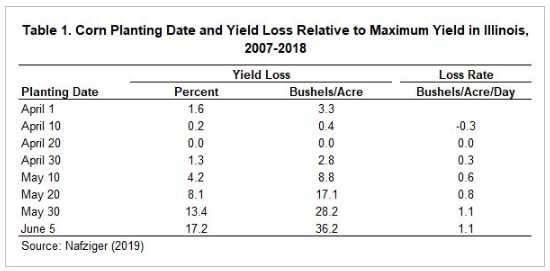
Results from corn planting date research for different years and different locations throughout the Corn Belt vary (e.g., Schafer, 2011), but the reported pattern of yield response to planting date is comparable to those presented by Nafziger. Examples of other recent research in this regard include Abendroth et al. (2017) and Long et al. (2017). We have previously defined the beginning date for substantial late planting penalties on corn yield in the U.S. to be May 20 (e.g.,
Irwin, Good, and Tannura, 2009). One can certainly argue for an earlier cutoff date, e.g., May 10, in the heart of the Corn Belt based on the data in Table 1 and other similar studies. However, we continue to opt for the May 20 date in light of the increasing corn acreage in the northwestern part of the Corn Belt and the later date of the optimal planting windows in these areas (Long et al., 2017). Figure 1 shows the percentage of corn planted late in the U.S. over 1980-2018 based on a May 30 cutoff from 1980 through 1985 and a May 20 cutoff date from 1986-2018. The change in cutoff dates in the mid-1980s reflects recommendations for earlier planting that appeared around that time. On average, late planting based on this measure was 16.8 percent, with the bulk of the observations between about 5 and 25 percent. There is no evidence of a trend up or down over time in the late planting percentage, which suggests that producer behavior in aggregate with respect to late corn planting has been quite stable.
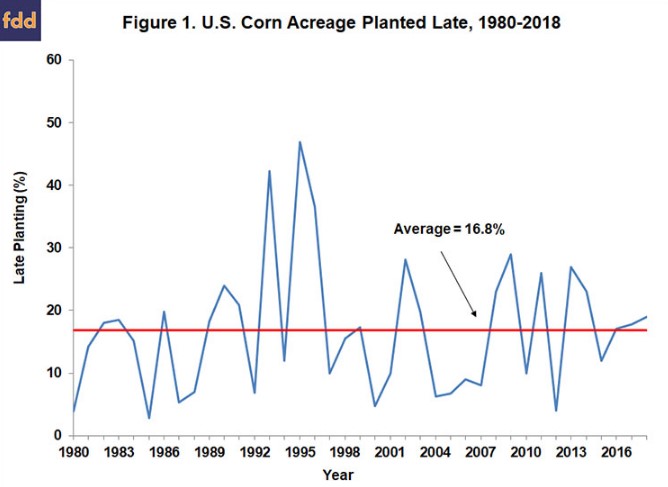
The third factor that will determine prospects for timely planting of the U.S. corn crop is the minimum number of days required to plant the U.S. crop. Note that this is simply stating the planting rate in terms of days rather than acres or percentage of the total planted acreage. We provided an updated estimate of the minimum number of days required to plant the U.S. corn crop in a farmdoc daily article last week (
April 17, 2019). We found that producers in Illinois, Indiana, and Iowa needed a minimum of 14 suitable field days, or two weeks, to plant the corn crop based on maximum daily rates of historical planting progress. Assuming the three states are representative of the entire Corn Belt, 14 days can also be used as an estimate of the minimum number of suitable field days needed to plant the entire U.S. corn crop. It is important to emphasize that this is the absolute minimum number of days required to plant the crop because it assumes that peak rates of planting progress can be maintained for all 14 days.
The fourth factor that will determine prospects for timely planting of the U.S. corn crop is the total number of days suitable for planting before the cutoff date for a significant late planting yield penalty, which we assume is May 20. If we begin counting on April 25, this means there is a total of 25 days until the May 20 cutoff date is hit. We need to know the historical distribution of suitable field days over this 25-day period in order to determine the likelihood of obtaining different numbers of planting days. Figures 1-3 show the distribution of suitable field days between April 25 and May 20 over 1980-2018 in Illinois, Indiana, and Iowa, respectively. Over the 39-year period, the average number of suitable field days during this 25-day period is 14 days for Illinois, 13 days for Indiana, and 14 days for Iowa. In other words, farmers are normally able plant about half the time during this time window. The range of suitable days is very wide in each state, with a minimum of 5 days and a maximum of 23 days in Illinois, a minimum of 3 days and a maximum of 24 days in Indiana, and a minimum of 7 days and a maximum of 22 days in Iowa.
We can now put the four factors together that determine timeliness to project late planting for the 2019 U.S. corn crop. We know that only six percent of the U.S. corn crop was planted as of April 21. We conservatively project that 10 percent will be planted by April 25. What we want to know is the chance of more than average late planting as of May 20th. As noted above, the average amount of late planting is 16.8 percent, which implies a target of 83.2 percent of corn acreage planted on May 20, or 73.2 percent planted between April 25 and May 20 (83.2 – 10 percent). We next need to convert 73.2 percent planted into suitable field days. Assuming 14 days is the minimum number of suitable field days required to plant the entire corn crop, approximately 10 suitable days will be needed to achieve 73.2 percent planted in the April 25 to May 20 window. Consulting Figures 2-4 as a guide, there is about a 70 to 90 percent chance of achieving 10 suitable field days or more in the heart of the Corn Belt, which is likely a reasonable benchmark for the rest of the U.S. Once again, it is important to emphasize that this should be thought of as the best-case scenario because we are assuming that farmers can plant at peak rates for all 10 suitable field days. It is probably more reasonable to assume that it will actually take 12 to 14 suitable field days to achieve 73 percent of the corn crop planted between April 25 and May 20. The chance of 14 suitable field days or more occurring in the 25 days drops to between about 45 and 55 percent, based on historical distributions for Illinois, Indiana, and Iowa.
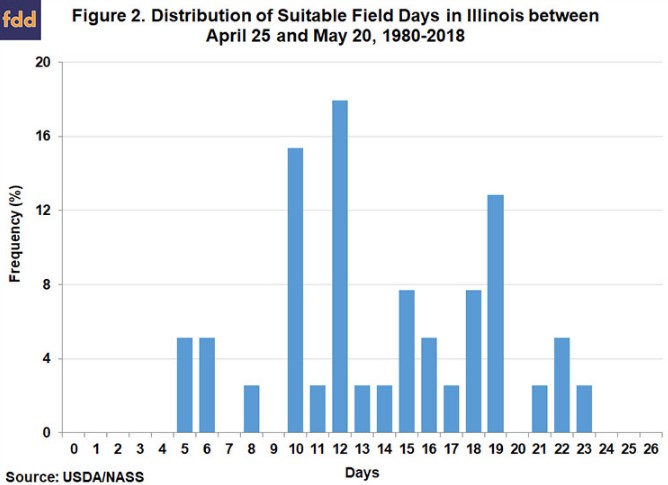
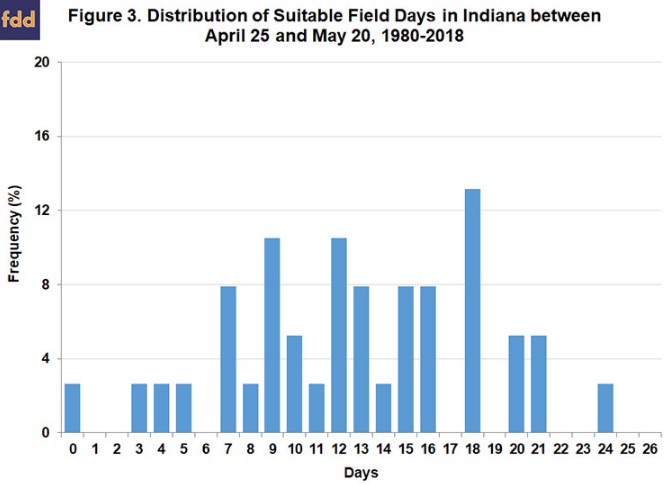

The above computations indicate that there is still sufficient time remaining to plant the 2019 U.S. corn crop in a timely manner. However, the computations are based on the historic distribution of suitable days for field work, which represents a wide range of conditions. In particular, soils are saturated throughout a considerable part of the Corn Belt due to heavy rains in recent weeks and months and this may impact the probability of obtaining the needed number of field days to plant the corn crop in a timely manner. Put differently, the unconditional distributions of historical field days in Figures 2-4 may be optimistic because they do not account for the relatively wet conditions this year.
Data on topsoil moisture levels is reported in the weekly Crop Progress reports form the USDA. These reports contains a topsoil moisture rating for major corn producing states each week. The rating categories are very short, short, adequate, and surplus. A percentage of total acreage is assigned to each category and the percentages add up to 100. Since we are interested in the impact of wet conditions on timeliness of planting, Figure 5 shows the percentage in the surplus category in Illinois as of April 22 (week# 16) over 1980 through 2019. We do not examine data for Indiana and Iowa because we could not collect surplus topsoil starting in 1980 for these two states. The surplus percentages are presented in rank order from smallest to largest. In about two-thirds of the years, surplus topsoil moisture in Illinois on this date in April is 30 percent or less. In the other one-third of the years, surplus topsoil moisture exceeds 30 percent, and often by a considerable amount. The surplus for 2019 is 54 percent, the 10th highest over this 39-year period.
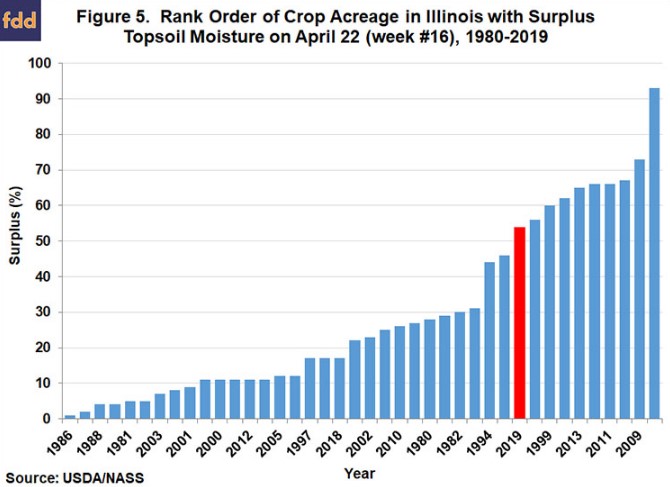
The question we can now address is whether topsoil moisture conditions in late April affect the number of suitable field days over the crucial planting window of April 25-May 20. Table 2 presents the level of surplus topsoil moisture and suitable field days for Illinois in this planting window sorted into two groups over 1980-2018. The first group of years has surplus topsoil moisture on April 22 in Illinois of 30 percent or below. The average topsoil surplus in this group of years is 14.3 percent and the average number of suitable field days between April 25 and May 20 is 15 days, one higher than the average of 14 days for the entire sample period. The second group of years have surplus topsoil moisture on April 22 in Illinois of more than 30 percent. The average topsoil surplus in this group of years is 60.8 percent and the average number of suitable field days between April 25 and May 20 is only 11 days, which is four less (or 27 percent) than number of field days when surplus topsoil moisture is below 30 percent. These results indicate that topsoil moisture conditions at the start of the April 25-May 20 planting window have a substantial impact on the expected number of suitable field days during this window. Essentially, this says that wet topsoil conditions at the start of the crucial April 25-May 20 planting window substantially diminish the likely number of suitable field days in Illinois during this window because it is hard for topsoil to dry out with normal precipitation and temperature.
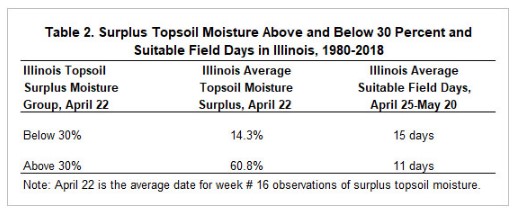
The previous evidence for Illinois is relevant, but before generalizing it is important to check whether this holds for the entire Corn Belt. We do this by computing an acreage-weighted topsoil surplus measure for 18 major corn producing states included in the weekly Crop Progress report. Unfortunately, this data set is only available starting in 1995. Figure 6 shows the percentage in the surplus category in the Corn Belt as of April 22 (week# 16) over 1995 through 2019. The surplus percentages are again presented in rank order from smallest to largest. Not too surprisingly, the data for the Corn Belt resembles that for Illinois found in Figure 5. In about one-third of the years, surplus topsoil moisture in the Corn Belt on this date in April is more than 30 percent, and the surplus for 2019 is 36 percent, the 5th highest over this 24-year period.
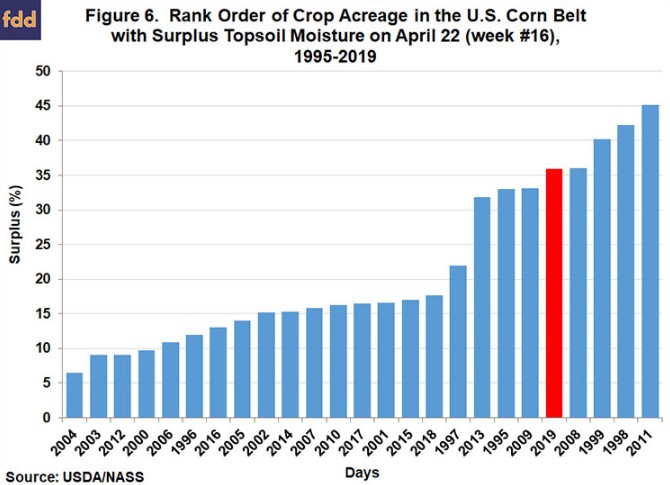
Rather than addressing whether topsoil moisture conditions in the Corn Belt during late April affect the number of suitable field days over April 25-May 20, we examine the impact on late planting directly. Table 3 presents the level of surplus topsoil moisture for the Corn Belt and late corn planting for the U.S. sorted into two groups over 1995-2018. The first group of years has surplus topsoil moisture on April 22 in the Corn Belt of 30 percent or below. The average topsoil surplus in this group of years is 13.9 percent and the average late planting is 14.3 percent. The second group of years have surplus topsoil moisture on April 22 in the Corn Belt of more than 30 percent. The average topsoil surplus in this group of years is 37.4 percent and the average late planting is 26.4 percent, which is 12.1 percentage points higher than when surplus topsoil moisture is below 30 percent. It is also interesting to drill down and examine individual years in the second group. There are seven years in the second group (1995, 1998, 1999, 2008, 2009, 2011, and 2013) and late corn planting is higher than the overall sample average in five of the seven years. For example, in 2008 the Corn Belt surplus topsoil moisture is 36 percent, the same as in 2019, and U.S. late planting was 23 percent. This is 5.2 percentage points above average late planting for the entire 1995-2018 sample period. Two years are exceptions (1998 and 1999), but late planting is only slightly below average in those years. In sum, mirroring the results for Illinois, the Corn Belt results indicate that topsoil moisture conditions at the start of the crucial April 25-May 20 planting window have a substantial impact on the expected level of late planting for corn in the U.S.
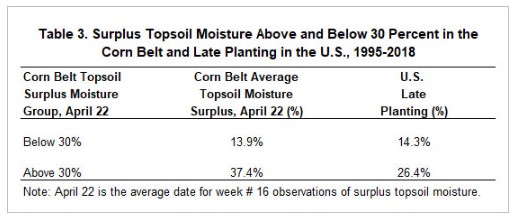
Implications
Wet conditions in much of the Corn Belt have hampered corn planting progress so far in 2019. This has led to concerns that more than the average percentage of U.S. corn acreage will be planted late. Computations using historical distributions of suitable field days indicates there is still sufficient time remaining to plant the 2019 U.S. corn crop in a timely manner (before May 20). However, these distributions do not account for the fact that topsoils are saturated throughout a considerable part of the Corn Belt due to heavy rains in recent weeks and months. We show that wet topsoil conditions at the start of the crucial April 25-May 20 planting window substantially diminish the likely number of suitable field days during this window because it is hard for topsoil to dry out with normal precipitation and temperature. We also find that when topsoil moisture surplus is similar to the current level for 2019 that late corn planting in the U.S. averages 26.4 percent, which is 12.1 percentage points higher than when topsoil moisture is normal. The bottom-line is that the current wet topsoil conditions in the Corn Belt do not bode well for planting the entire U.S. corn crop in a timely manner. A reasonable estimate is that late corn planting in 2019 will be at least 5 to 10 percent above average. We will draw implications of projected late planting for the 2019 U.S. average corn yield in a farmdoc daily article next week.